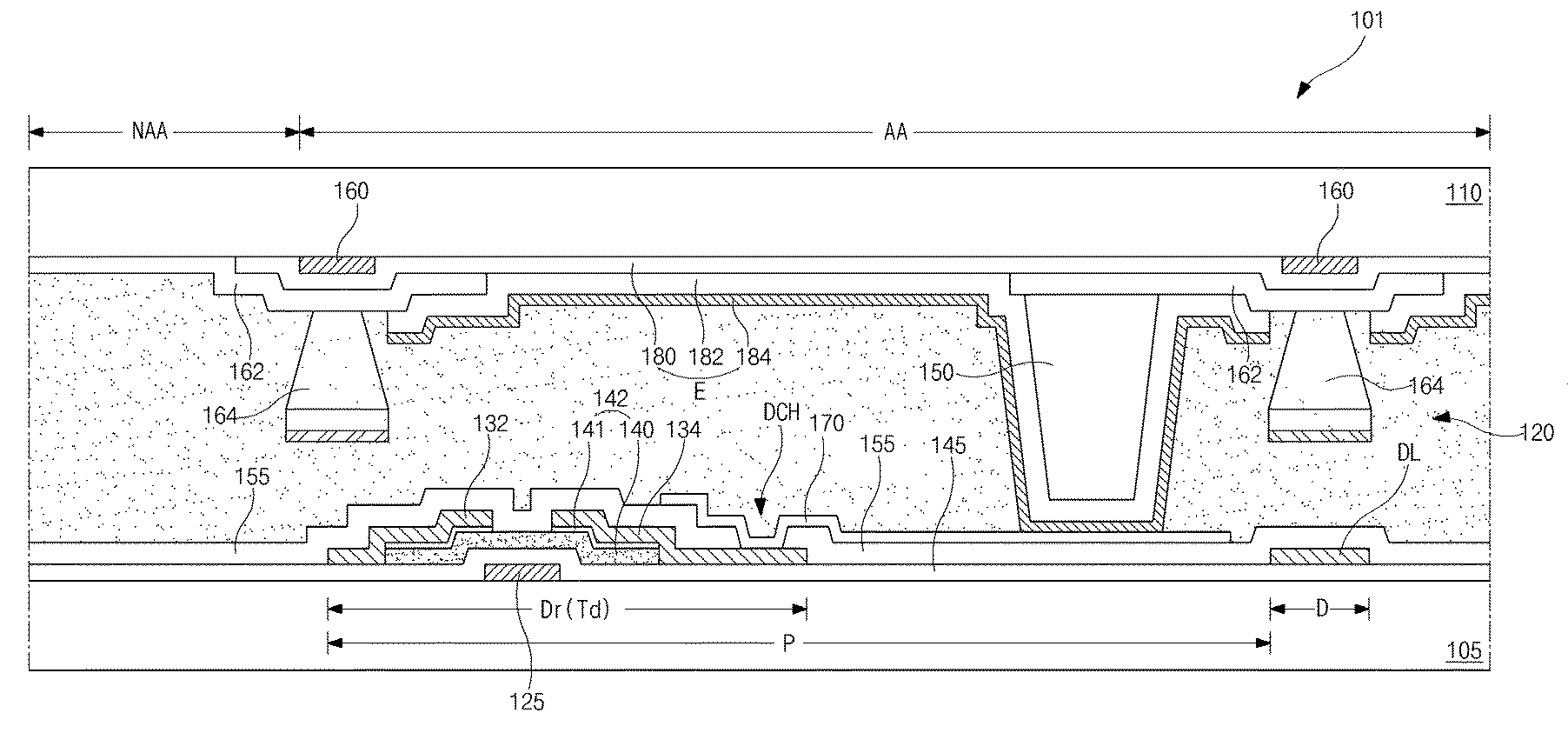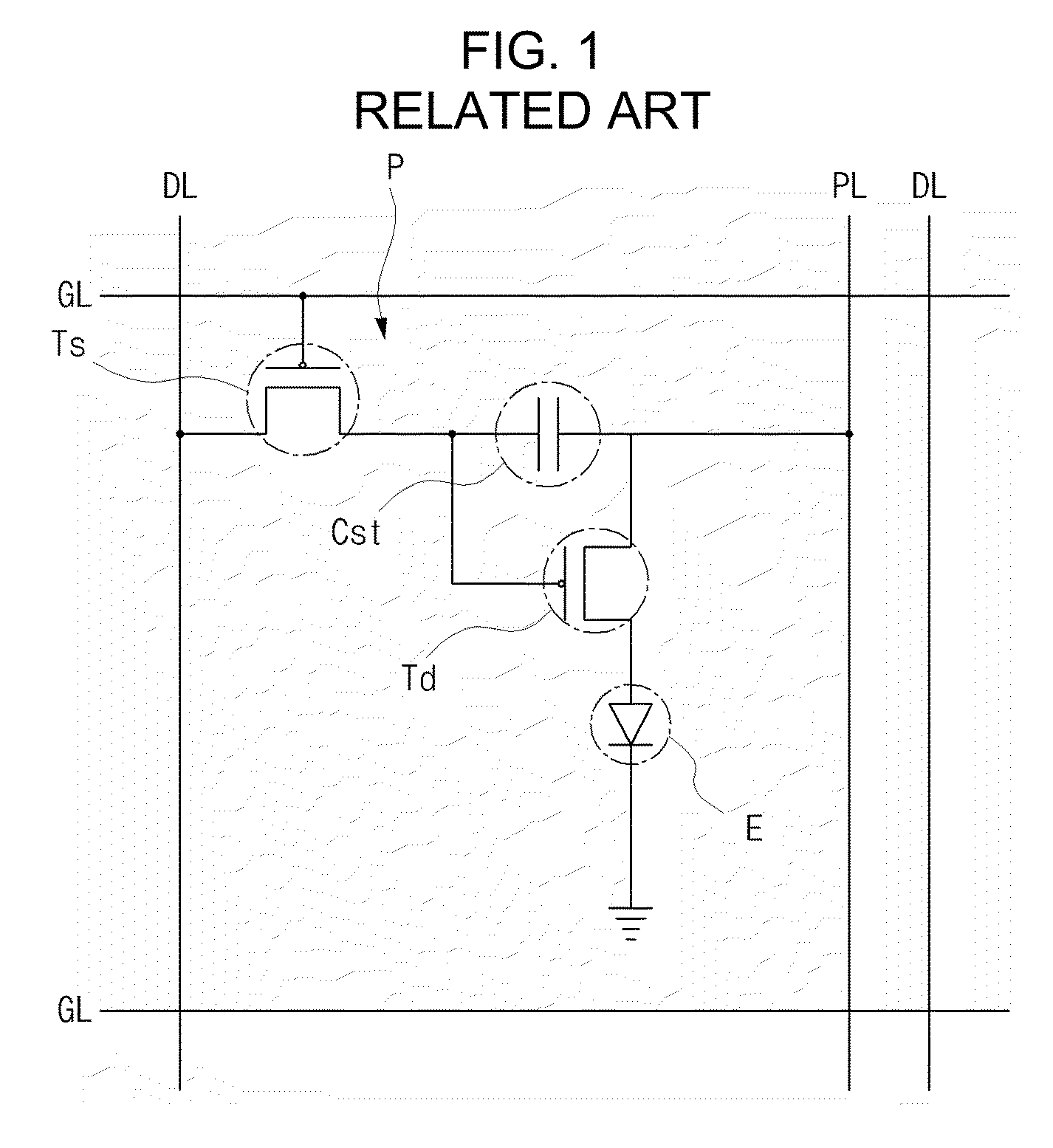Organic electroluminescent display device and method and apparatus of manufacturing the same
a technology of electroluminescent display and organic electroluminescent, which is applied in the manufacture of electrode systems, electric discharge tubes/lamps, discharge tubes luminescent screens, etc., can solve the problems of short response time, high brightness, and wide viewing angle of oeld devices, and achieve the effect of improving display quality and production efficiency
- Summary
- Abstract
- Description
- Claims
- Application Information
AI Technical Summary
Benefits of technology
Problems solved by technology
Method used
Image
Examples
first embodiment
[0052]FIG. 3 is a cross-sectional view illustrating a dual plate type OELD device according to the present invention.
[0053]Referring to FIG. 3, the OELD device 101 includes an array substrate and an opposing substrate. The OELD device 101 includes a display region AA to display images and a non-display region NAA. The non-display region NAA is a peripheral region of the OELD device 101. The non-display region NAA may surround the display region AA. The display region AA may include a plurality of pixel regions P in a matrix form.
[0054]The array substrate includes a gate line (not shown) and a data line DL on a first substrate 105 to cross each other to define the pixel region P. The data line DL is formed in a data region D. In the pixel region P, a switching thin film transistor (not shown) and a driving thin film transistor Td are formed. The switching thin film transistor is connected to the corresponding gate line and data line DL. The driving thin film transistor Td is formed i...
second embodiment
[0098]FIG. 7A is a schematic plan view illustrating an OELD device according to the present invention, and FIGS. 7B and 7C are pictures, of first to fourth regions of the OELD device of FIG. 7A, taken in reliability tests on the OELD device.
[0099]Referring to FIG. 7A, the OELD device includes an array substrate and an opposing substrate with an adhesive layer therebetween. The OELD device includes a display region AA and a non-display region surrounding the display region NAA. A seal pattern 290 is at the non-display region NAA.
[0100]FIG. 7B shows lighting statuses of first to fourth regions (1) to (4) of the OELD device at a first elapsed time after the OELD device is transferred into a chamber under conditions that a temperature is about 80° C. and a humidity is about 95%, and FIG. 7C shows lighting status of first to fourth regions (1) to (4) of the OELD device at a second elapsed time after the OELD device is transferred into a chamber under conditions that a temperature is abou...
third embodiment
[0107]FIGS. 9A and 9B are pictures, of two corner regions of each of OELD devices according to the present invention, taken in reliability tests on the OELD devices.
[0108]The test of FIG. 9A is made on an OELD device which has three shield patterns 386 having a width of about 60 μm, and the two corners (1) and (2) are two among four corners of the OELD device. When the three shield patterns 386 are used, defects on pixels due to moisture permeation occur from the outside of a display region into the inside after a lapsed time of about 1000 hours.
[0109]The test of FIG. 9B is made on an OELD device which has six shield patterns 386 having a width of about 60 μm, and the two corners (1) and (2) are two among four corners of the OELD device. When the six shield patterns 386 are used, defects on pixels due to moisture permeation occur from the outside of a display region into the inside after a lapsed time of about 1600 hours.
[0110]FIG. 10 is pictures, of a corner region of each of displ...
PUM
 Login to View More
Login to View More Abstract
Description
Claims
Application Information
 Login to View More
Login to View More - R&D
- Intellectual Property
- Life Sciences
- Materials
- Tech Scout
- Unparalleled Data Quality
- Higher Quality Content
- 60% Fewer Hallucinations
Browse by: Latest US Patents, China's latest patents, Technical Efficacy Thesaurus, Application Domain, Technology Topic, Popular Technical Reports.
© 2025 PatSnap. All rights reserved.Legal|Privacy policy|Modern Slavery Act Transparency Statement|Sitemap|About US| Contact US: help@patsnap.com



